While most of nature seems to be ahead of schedule here, I am far behind where I ought to be in terms of finished works for the forthcoming Catterline exhibition. As far as I know, I am still due to exhibit at the Creel Inn in November and December, but I am going to have to put my foot firmly on the accelerator pedal for the next few months if I'm going to meet my own set target of 25 new works to take down on the ferry with me.
The trouble is, I'm getting far too fussy nowadays. I pick complicated scenes, I hate to be lacking in any minute detail, and it takes far too long to finish. Tomorrow I hope to have finished my ultra-fussy painting of the back of Burnside, Fettercairn, and after that I am going to embark on a series of seascapes, which are less complicated and consequently less time-consuming.
Other things make demands on my time too. On Thursday afternoon I took two tall ship paintings to my local printing firm Tay-CAD for scanning, with a view to extending my stock range of giclee prints to offer at my stall at the Toll Clock Centre during the visit of the Tall Ships racers in late July. I'm looking forward with some excitement to this event, and I hope the weather conditions are more favourable to the participating windjammers than they were on their last call here in 1999.
On that occasion the wind was dead against them on all three races, and they were forced to tack and gybe from St. Malo to Greenock, Greenock to Lerwick and Lerwick to Aalborg. In the event-filled second stage, a Polish crew mutinied in Greenock, a Russian vessel was dismasted in the Moray Firth, and another boat went aground in the Summer Isles. Two days after it had all finished, as far as Lerwick was concerned, the Mallaig-based converted fishing vessel "Eda Frantsen" arrived back in, having tacked for 36 hours in the south-easterly gale, and only made 30 miles. Our own tall ship, the "Swan", had to put in to Egersund in south Norway, unable to make the necessary southerly miles to get to Aalborg in Denmark.
This year, I hope the winds are fairer. Certainly the party at Lerwick won't let anybody down!
The Grumpy Old Artist

Would YOU pose for this man???
Exhibition Poster

Catterline Event, 2011
Oil Painting by Jim Tait
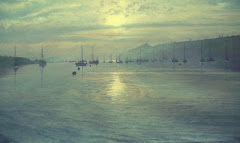
Helford River, Cornwall
Oil Painting by Jim Tait
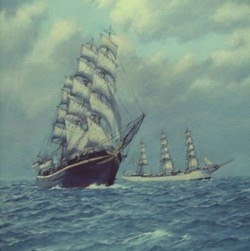
Full-riggers "Georg Stage" and "Danmark"
Other Recent Works
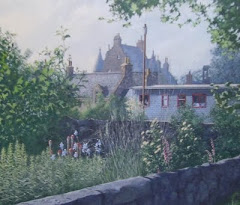
Fordyce Castle and Village

Hay's Dock, Lerwick

Shetland-model Boats at Burravoe, Yell
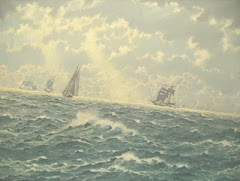
Tall Ships Seascape

The Tour Boat "Dunter III", with Gannets, off Noss
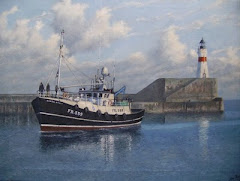
The "Karen Ann II" entering Fraserburgh harbour
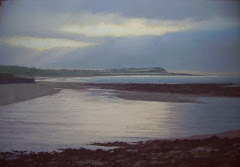
Summer Evening, Boyndie Bay
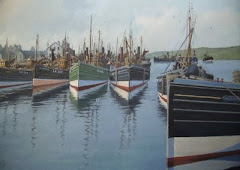
1930s Lerwick Harbour

Johnshaven Harbour
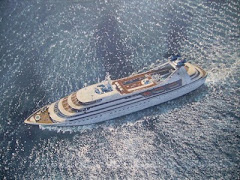
"Seabourn Legend"
Greeting Cards!

Now Available in Packs of Five or in Assorted Sets of Four
Sunday, 29 May 2011
MORE ON DRIP STRIP!
Further to my posting of Wednesday 16th February, I feel I must extol further the excellent practical properties of drip strip from an artist's point of view. This spongy stuff, which people used to soak up water caused by condensation in internal window-sills, in the good days before double-glazing salesmen, has other applications than those for which it was designed.
Kept damp (not soaking wet), and placed in between the canvas and the inner edge of the stretcher frames, it prevents ridges appearing where brush pressure has been applied to the canvas surface. I apply my paint straight from the tube, with no thinners of any kind, so I tend to scrub my undercoats in vigorously to keep down on the little pinprick "holidays" left due to the canvas grain.
But there's more - can you stand it? I decided to see if the same stuff would work with earlier artworks which had been spoilt by the unsightly ridges. I took one such previously completed painting, applied the drip strip (once again damp, not soaking wet!) in a similar place, to cover the frame-edges, placed the painting rightway up, and put a few reference books (dictionary size!) on top of the ridges. I then left it for a day or so, and, when I took the books off, the ridges had all but completely disappeared.
I wish to make clear that I am not getting a penny from the manufacturers of drip strip for this post, neither were any animals hurt in the process outlined above. This is just another handy hint from the pen of your friendly handyman artist - a kind of cross between Van Gogh, Tommy Walsh and Anneka Rice. Remember where you heard it first.
Kept damp (not soaking wet), and placed in between the canvas and the inner edge of the stretcher frames, it prevents ridges appearing where brush pressure has been applied to the canvas surface. I apply my paint straight from the tube, with no thinners of any kind, so I tend to scrub my undercoats in vigorously to keep down on the little pinprick "holidays" left due to the canvas grain.
But there's more - can you stand it? I decided to see if the same stuff would work with earlier artworks which had been spoilt by the unsightly ridges. I took one such previously completed painting, applied the drip strip (once again damp, not soaking wet!) in a similar place, to cover the frame-edges, placed the painting rightway up, and put a few reference books (dictionary size!) on top of the ridges. I then left it for a day or so, and, when I took the books off, the ridges had all but completely disappeared.
I wish to make clear that I am not getting a penny from the manufacturers of drip strip for this post, neither were any animals hurt in the process outlined above. This is just another handy hint from the pen of your friendly handyman artist - a kind of cross between Van Gogh, Tommy Walsh and Anneka Rice. Remember where you heard it first.
Sunday, 15 May 2011
OCEAN-GOING TALL SHIPS
When I held my last exhibition at the Creel Inn, Catterline, in early 2008, the success of it was due, in no small measure, to the efforts of my nephew Kenneth Halcrow. He provided the transport, he devised and executed the system for hanging the paintings, he drove all over the Mearns and beyond, distributing the posters which I'd had designed for the event, and he sought out and searched through DIY shops in Inverbervie and Montrose for more picture wire, a large amount of which turned out to be an integral part of the hanging arrangement.
He also chided and corrected me if my customer service came short of the mark. On the first afternoon, while we were in the process of the hanging operation, a couple of local men of senior years arrived to see what was on display. They were heard to lament the lack of sailing ships among the subject matter, and Kenneth made sure that I had taken note of this deficiency for future displays. He also saw that I handed out business cards liberally to anyone was showing even the slightest interest in the artworks. In short, if he had not been there supporting me (and I was still recovering from a serious knee complaint which had only been operated on a couple of months previously), I think I would have broken down and wept when I saw the magnitude of the task before me when I arrived at the exhibition venue that Monday morning!
So, mindful of the lack of sail-power evident in my last Catterline show, I have been doing a few tall ship paintings over the past year or so, and this is the latest. It depicts the 32.9m schooner "Johann Smidt" in fresh weather and an ocean swell, with one of the large 1980s-Polish-built flush-deckers in a trough behind her, and other sailing vessels visible in the distance. I'm quite pleased with my sea, and I hope it attracts some favourable comment (perhaps even a buyer ultimately!). It is available, along with many other goodies, from the Gallery Shop on my website http://www.tait-gallery.co.uk/Product-Page-1.aspx
The schooner "Johann Smidt" was built for Dutch owners in 1974 as the "Eendracht", but was sold to her current German owners when the new larger three-masted schooner "Eendracht" was built in 1989. Both these ships were in Lerwick in 1999 for the Tall Ships Race, and I hope to see them here again this year. I'm sure it will be a splendid spectacle and party, and I've booked my stall at the Toll Clock Centre for the occasion. Arr, Jim lad! See you there!
He also chided and corrected me if my customer service came short of the mark. On the first afternoon, while we were in the process of the hanging operation, a couple of local men of senior years arrived to see what was on display. They were heard to lament the lack of sailing ships among the subject matter, and Kenneth made sure that I had taken note of this deficiency for future displays. He also saw that I handed out business cards liberally to anyone was showing even the slightest interest in the artworks. In short, if he had not been there supporting me (and I was still recovering from a serious knee complaint which had only been operated on a couple of months previously), I think I would have broken down and wept when I saw the magnitude of the task before me when I arrived at the exhibition venue that Monday morning!
So, mindful of the lack of sail-power evident in my last Catterline show, I have been doing a few tall ship paintings over the past year or so, and this is the latest. It depicts the 32.9m schooner "Johann Smidt" in fresh weather and an ocean swell, with one of the large 1980s-Polish-built flush-deckers in a trough behind her, and other sailing vessels visible in the distance. I'm quite pleased with my sea, and I hope it attracts some favourable comment (perhaps even a buyer ultimately!). It is available, along with many other goodies, from the Gallery Shop on my website http://www.tait-gallery.co.uk/Product-Page-1.aspx
The schooner "Johann Smidt" was built for Dutch owners in 1974 as the "Eendracht", but was sold to her current German owners when the new larger three-masted schooner "Eendracht" was built in 1989. Both these ships were in Lerwick in 1999 for the Tall Ships Race, and I hope to see them here again this year. I'm sure it will be a splendid spectacle and party, and I've booked my stall at the Toll Clock Centre for the occasion. Arr, Jim lad! See you there!
Labels:
artwork,
exhibitions,
ocean swell,
oil paintings,
seascapes,
tall ships
Sunday, 8 May 2011
THEY'RE BACK!
Yesterday morning, I went for my quarterly (roughly!) appointment at the hairdresser's in Mounthooly Street, Lerwick. Duly shorn of my "mooskit" locks, I took my predetermined walk home by the "scenic route", calling along the Spar shop in Thorfinn Street before walking down Breiwick Road. For part of its length, this follows the line of the lower "Battery Banks" and the Waari Geo, where Lerwick Swimming Club members used to meet in the days of my youth, when men were men and women were a bunch of hard cases. (I hasten to add that I never swam myself, being an asthmatic wimp, with miatonia congenita and a wonderful sense of self-preservation, coupled with a tendency towards cowardice). Nowadays most of the swimming is done in the more benign climate of the Clickimin Centre pool, although, given a warm summer day, the beach at the Sands of Sound, and others throughout the islands, will still ring out with the shrieks and laughter of people "gyaain in for a dip" in the sea.
I digress, however (a filthy habit - I know!). I walked down the road named after Breiwick Bay, which I was now surveying (for what I couldn't tell), when suddenly I heard the unmistakable rasping calls of the arctic tern. Sure enough, two of the graceful "sea-swallows" were diving, swerving and ducking over the shallow water at "Da Sletts", and shrieking as if engaged in a heated domestic argument with each other. This sound of the "tirrick" is definitive of the Shetland summer, and it's nice to see them back. A pity the fine weather of the past week seems to have left us, but maybe that will return too!
I digress, however (a filthy habit - I know!). I walked down the road named after Breiwick Bay, which I was now surveying (for what I couldn't tell), when suddenly I heard the unmistakable rasping calls of the arctic tern. Sure enough, two of the graceful "sea-swallows" were diving, swerving and ducking over the shallow water at "Da Sletts", and shrieking as if engaged in a heated domestic argument with each other. This sound of the "tirrick" is definitive of the Shetland summer, and it's nice to see them back. A pity the fine weather of the past week seems to have left us, but maybe that will return too!
Monday, 2 May 2011
THE END OF A LONG AND WINDING ROAD
Calm down, dear! This is not a painting (yet!). This house stands at the end of a long, winding and bumpy road, and I took this photograph yesterday, after my sister Mary and I had navigated this vergeless, barrier-less, and mostly tarred highway to the hamlet of Nibon, in Shetland's north mainland, in unbroken sunshine yesterday. There are only three dwelling houses, along with two holiday chalets, in this isolated and beautiful spot and, as far as I can remember, I have never been here before.
On the way to Nibon, we passed the end of the side-road which leads downhill to the isolated croft of Gunnister, which stands near the head of the voe of the same name, while on the other side of the valley is the other hamlet of Ennisfirth, access to which is by another side-road leading from a more northerly turn-off from the main road north. Perhaps the most remarkable thing I noticed about this area is the complete lack of new buildings (apart from the holiday chalets), which have been springing up aplenty in other parts of the islands over the last few decades. And another thing - that road must be the devil's own to negotiate in wintry conditions!
The trip north was the result of my contract to supply the St Magnus Bay Hotel with a series of paintings on the theme of the North of Scotland, Orkney and Shetland Steam Navigation Company's relationship with this area (and former ownership of the hotel). I had consulted my OS map and, according to that, the best vantage point for getting a photograph of the Ness of Hillswick (which the ships would have had to pass on their way to and from the anchorage in the bay opposite the hotel) would be the end of the Nibon road. I bribed my sister with the promise of a meal in the hotel's restaurant (which does an excellent carvery on Sundays), booked our table, and off we set yesterday. The photographic part of the mission was reasonably successful, the meal was excellent, and we delivered the five paintings which represent the first completed works in a series of many for this impressive establishment. We took the paintings to the first-floor drawing room, which is a spacious and grand affair, and I feel good about having an association with this splendid and historically significant building. I wish the new owners every success in their venture.
The commission is also a long and winding road, of which the end is yet nowhere near in sight, and I have somehow to fulfil this along with my Catterline exhibition. As far as I know, I still have to produce the latter for sometime around the beginning of November, although I have yet to hear anything from them about actual dates. I hope to get these soon. More on the St. Magnus Bay Hotel commission, and the two historical incidents which are connected to this place, and which I have been asked to portray on canvas, in the near future. Enjoy your week!
On the way to Nibon, we passed the end of the side-road which leads downhill to the isolated croft of Gunnister, which stands near the head of the voe of the same name, while on the other side of the valley is the other hamlet of Ennisfirth, access to which is by another side-road leading from a more northerly turn-off from the main road north. Perhaps the most remarkable thing I noticed about this area is the complete lack of new buildings (apart from the holiday chalets), which have been springing up aplenty in other parts of the islands over the last few decades. And another thing - that road must be the devil's own to negotiate in wintry conditions!
The trip north was the result of my contract to supply the St Magnus Bay Hotel with a series of paintings on the theme of the North of Scotland, Orkney and Shetland Steam Navigation Company's relationship with this area (and former ownership of the hotel). I had consulted my OS map and, according to that, the best vantage point for getting a photograph of the Ness of Hillswick (which the ships would have had to pass on their way to and from the anchorage in the bay opposite the hotel) would be the end of the Nibon road. I bribed my sister with the promise of a meal in the hotel's restaurant (which does an excellent carvery on Sundays), booked our table, and off we set yesterday. The photographic part of the mission was reasonably successful, the meal was excellent, and we delivered the five paintings which represent the first completed works in a series of many for this impressive establishment. We took the paintings to the first-floor drawing room, which is a spacious and grand affair, and I feel good about having an association with this splendid and historically significant building. I wish the new owners every success in their venture.
The commission is also a long and winding road, of which the end is yet nowhere near in sight, and I have somehow to fulfil this along with my Catterline exhibition. As far as I know, I still have to produce the latter for sometime around the beginning of November, although I have yet to hear anything from them about actual dates. I hope to get these soon. More on the St. Magnus Bay Hotel commission, and the two historical incidents which are connected to this place, and which I have been asked to portray on canvas, in the near future. Enjoy your week!
Subscribe to:
Comments (Atom)










